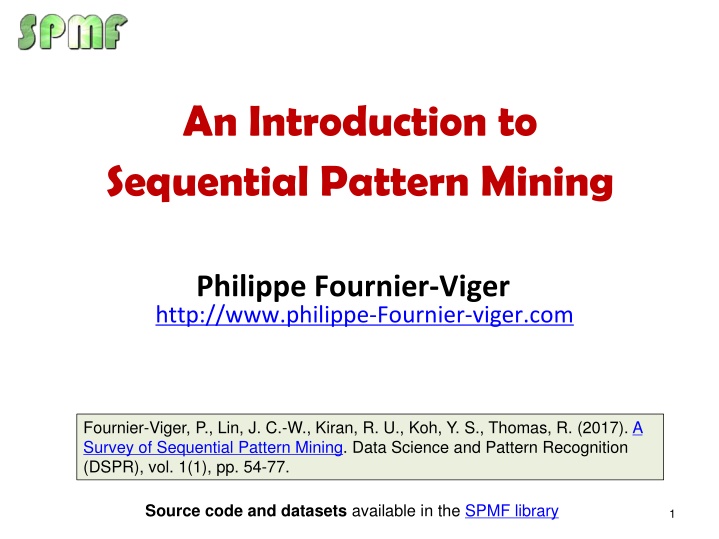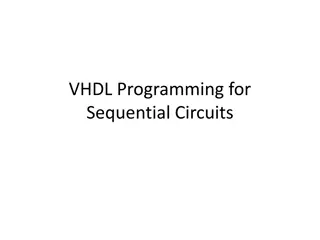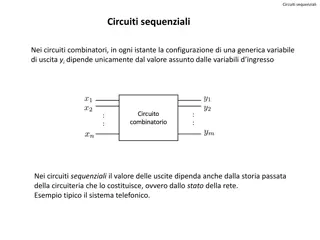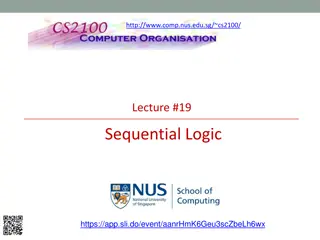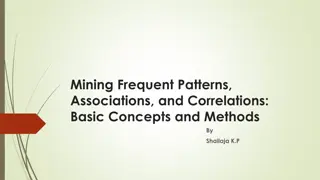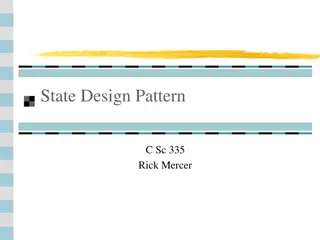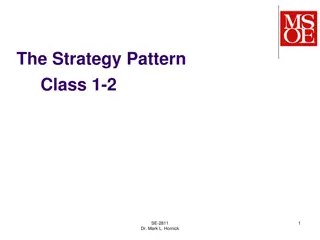Introduction to Sequential Pattern Mining Overview
Discover the concept of sequential pattern mining, a popular data mining task introduced in 1994, with a focus on analyzing discrete sequences to find interesting patterns. Sequential pattern mining involves finding frequent subsequences in sets of discrete sequences, such as items purchased by customers, locations visited by tourists, or common words in text. Learn about discrete sequences, itemsets, and the goal of extracting useful knowledge from various data types. Source code and datasets are available in the SPMF library.
Download Presentation

Please find below an Image/Link to download the presentation.
The content on the website is provided AS IS for your information and personal use only. It may not be sold, licensed, or shared on other websites without obtaining consent from the author.If you encounter any issues during the download, it is possible that the publisher has removed the file from their server.
You are allowed to download the files provided on this website for personal or commercial use, subject to the condition that they are used lawfully. All files are the property of their respective owners.
The content on the website is provided AS IS for your information and personal use only. It may not be sold, licensed, or shared on other websites without obtaining consent from the author.
E N D
Presentation Transcript
An Introduction to Sequential Pattern Mining Philippe Fournier-Viger http://www.philippe-Fournier-viger.com Fournier-Viger, P., Lin, J. C.-W., Kiran, R. U., Koh, Y. S., Thomas, R. (2017). A Survey of Sequential Pattern Mining. Data Science and Pattern Recognition (DSPR), vol. 1(1), pp. 54-77. Source code and datasets available in the SPMF library 1
Introduction Data Mining: the goal is to discover or extract useful knowledge from data. Many types of data can be analyzed: graphs, relational databases, time series, sequences, etc. In this presentation, we focus on analyzing a common type of data called discrete sequences to find interesting patterns in it. 2
What is a discrete sequence? A sequence is an ordered list of symbols. Example 1: a sequence can be the items that are purchased by a customer over time: Computer Monitor Router 3
What is a discrete sequence? A sequence is an ordered list of symbols. Example 2: a sequence can be the list of words in a sentence: back home go I 4
What is a discrete sequence? A sequence is an ordered list of symbols. Example 3: a sequence can be the list of locations visited by a car in a city f g b a a c b d e f g h 5
Sequential Pattern Mining It is a popular data mining task, introduced in 1994 by Agrawal & Srikant. The goal is to find all subsequences that appear frequently in a set of discrete sequences. For example: find sequences of items purchased by many customers over time, find sequences of locations frequently visited by tourists in a city, Find sequences of words that appear frequently in a text. 6
Definition: Items Let there be a set of items (symbols) called ?. Example: ? = {?,?,?,?,?} ? = apple ? = dattes ? = bread ? = eggs ? = cake 7
Definition: Itemset An itemset is a set of items that is a subset of ?. Example: {?,?,?} is an itemset containing 3 items {?,?} is an itemset containing 2 items Note: an itemset cannot contain a same item twice. An itemset having ? items is called a k-itemset. 8
Definition: Sequence A discrete sequence ? is a an ordered list of itemsets ? = ?1,?2, ,?? where ?? ? for any ? {1,2..?} Example 1: ?,? , ? is a sequence containing two itemsets. It means that a customer purchased ????? and ????? at the same time and then purchased ????. Example 2: ? , ? ,{?} 9
Definition: Subsequence () Let there be two sequences: ??= ?1,?2, ,?? and S?= ?1,?2, ,??. The sequence ??is a subsequence of S?if and only if there exists ? integers 1 ?1 < ?2 < < ?? ? such that ?1 ??1,?2 ??2, ?? ???. This is denoted as SA ?? Examples: ?,? ?,?,? ?,? ?},{? ? , ? ?,? ,{?}, ?,? ? , ? ?,? ,{?} 10
Definition: Sequence database A sequence database ? is a set of discrete sequences ? = {?1,?2, ??} where each sequence ?? ? has a unique identifier ?. Example 1: This is a sequence database with four sequences ? = {?1,?2,?3,?4} : Sequence database ?1= ?2= ?3= ?4= ?,? , ? , ? ? , ? , ? ? , ? ,{?} ? , ?,? ,{?} 11
Definition: Support of a sequence The number of sequences in a sequence database ? that contain a sequence ??is called the support of ??. It is defined as: ???(??) = | ? ? ? ??? ?? ?}| Example 1: Sequence database ???( ? ) = 3 ?1= ?2= ?3= ?4= ?,? , ? , ? ? , ? , ? ? , ? ,{?} ? , ?,? ,{?} 12
Definition: Support of a sequence The number of sequences in a sequence database ? that contain a sequence ??is called the support of ??. It is defined as: ???(??) = | ? ? ? ??? ?? ?}| Example 2: Sequence database ???( ? ) = 4 ?1= ?2= ?3= ?4= ?,? , ? , ? ? , ? , ? ? , ? ,{?} ? , ?,? ,{?} 13
Definition: Support of a sequence The number of sequences in a sequence database ? that contain a sequence ??is called the support of ??. It is defined as: ???(??) = | ? ? ? ??? ?? ?}| Example 3: Sequence database ?1= ?2= ?3= ?4= ?,? , ? , ? ? , ? , ? ? , ? ,{?} ? , ?,? ,{?} ???( {?},{?} = 1 14
Definition: Support of a sequence The number of sequences in a sequence database ? that contain a sequence ??is called the support of ??. It is defined as: ???(??) = | ? ? ? ??? ?? ?}| Example 4: Sequence database ???( ?,? ) = 2 ?1= ?2= ?3= ?4= ?,? , ? , ? ? , ? , ? ? , ? ,{?} ? , ?,? ,{?} 15
Definition: Sequential pattern mining Input: A sequence database ? and a minimum support threshold ?????? > 0. Output: All sequential patterns. A sequential pattern is a sequence ? where sup ? ??????. 16
Example 1 INPUT: OUTPUT: Sequence database ?1= ?2= ?3= ?4= ?,? , ? , ? ?,? , ? , ? ? , ? ,{?} ? , ?,? ,{?} ?????? = 3 17
Example 1 INPUT: OUTPUT: Sequence database all sequential patterns: ?support = 3 ? support = 4 ? support = 4 ? ,{?}support = 3 ?,? support = 2 ? ,{?} support = 4 ?,? ,{?} support = 3 ?1= ?2= ?3= ?4= ?,? , ? , ? ?,? , ? , ? ? , ? ,{?} ? , ?,? ,{?} ?????? = 3 What will happen if we change the threshold? 18
Example 2 INPUT: OUTPUT: Sequence database ?1= ?2= ?3= ?4= ?,? , ? , ? ?,? , ? , ? ? , ? ,{?} ? , ?,? ,{?} ?????? = 4 Observation: If we increase the minsup threshold, less patterns may be found 19
Example 2 INPUT: OUTPUT: Sequence database all sequential patterns: ? support = 4 ? support = 4 ? ,{?} support = 4 ?1= ?2= ?3= ?4= ?,? , ? , ? ?,? , ? , ? ? , ? ,{?} ? , ?,? ,{?} ?????? = 4 Observation: If we increase the minsup threshold, less patterns may be found 20
It is a difficult problem! A na ve algorithm would read the database and count the support (frequency) of all possible patterns. Inefficient because there can be a very large number of sequential patterns. For example: ? , ? , ? . . ?,? , ?,? , ?,? ? , ? , ?},{? ? , . . An efficient algorithm must find the frequent sequential patterns, without checking all possibilities. ? , ? , ? , ? , ? , ? , ? . ?,? ? , . 21
Some popular algorithms GSP: R. Agrawal, and R. Srikant, Mining sequential patterns, ICDE 1995, pp. 3 14, 1995. SPAM: Ayres, J. Flannick, J. Gehrke, and T. Yiu, Sequential pattern mining using a bitmap representation, KDD 2002, pp. 429 435, 2002. SPADE: M. J. Zaki, SPADE: An efficient algorithm for mining frequent sequences, Machine learning, vol. 42(1-2), pp. 31 60, 2001. PrefixSpan: J. Pei, et al. Mining sequential patterns by pattern-growth: The prefixspan approach, IEEE Transactions on knowledge and data engineering, vol. 16(11), pp. 1424 1440, 2004. CM-SPAM and CM-SPADE: P. Fournier-Viger, A. Gomariz, M. Campos, and R. Thomas, Fast Vertical Mining of Sequential Patterns Using Co-occurrence Information, PAKDD 2014, pp. 40 52, 2014. They all have the same input and output. The difference is performance due to optimizations, search strategies and data structures! Fast implementations available in the SPMF library 22
A performance comparison Four benchmark datasets are used Kosarak BMS Leviathan Snake 23
The Apriori property Property (anti-monotonicity). Let be two subsequences X and Y. If X ?, then the support of Y is less than or equal to the support of X. Example Sequence database ?1= ?2= ?3= ?4= ?,? , ? , ? ?,? , ? , ? ? , ? ,{?} ? , ?,? ,{?} The support of ? is 4 The support of ? , ? The support of ? , ? ,{?} is is 1 1 is is 4 4 24
